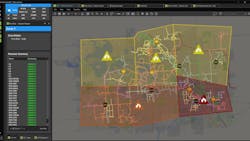Using Digital Grid Management Solutions to Improve Safety & Reliability
More than any other point in modern history, utilities are under extreme pressure. In addition to grappling with aging infrastructure and new spikes in energy demand, external threats such as cybersecurity and weather-related events are causing the industry to adopt new business models, safeguards, and technology. Utilities have seen a surge of extreme weather events in recent years with wildfire mitigation becoming one of their biggest priorities to ensure a safe and reliable grid.
Just in the last few years, damage by wildfires in the U.S. has been catastrophic. According to the National Interagency Fire Center, 2.6 million acres burned nationwide in 2023, compared to 7.5 million acres in 2022 and more than 10 million acres in 2020. Despite the dip in 2023, wildfire mitigation will almost certainly be at the top of utilities’ priority lists for the foreseeable future. It’s easy to understand why. The service disruption caused by wildfires is significant and fines can be in the billions. But, most importantly, the possible loss of human life, wildlife, and environmental damage, is impossible to put a price tag on.
According to the North American Electric Reliability Corporation (NERC), “Electric utilities in high fire-threat areas should have plans or strategies to address and mitigate the threat of electrical infrastructure or equipment causing ignitions that could lead to wildfires and/or being impacted or damaged by wildfires.” In fact, in California, legislation mandates publicly owned electric utilities to have a comprehensive strategy and defense against wildfires.
The message is clear – mitigating the threat of wildfires is a matter of both public safety and business continuity. Due to these factors, utilities are seeking out new digital strategies and tools to help them be more proactive and effective in the way they mitigate wildfire threats.
Recently, they’ve started to rely on operational technology software solutions to help improve grid reliability. Similar solutions are already being used by utilities to mitigate other reliability challenges, such as unpredictable energy demand and high penetrations of distributed energy resources (DERs). Digitalization and data are enabling utilities to modernize strategies from wildfire mitigation to the energy transition.
Threats to System Reliability
To date, the tools available for wildfire prevention have been inadequate. When an overhead transmission or distribution line falls to the ground, the upstream protective device trips and recloses to protect that section of the line, then attempts to restore power. Reclosing is a very effective tool in mitigating transient faults on the system, often resulting in power being restored. However, reclosing a power line at utility-level voltages involves a significant amount of potential energy. If that wire happens to be lying among dry leaves or brush, it could create a spark and an eventual wildfire.
In an attempt to prevent this from happening during periods of high fire risk, utilities will often manually disable reclosing on protective equipment to prevent downed power lines from being re-energized. In extreme cases in which the fire and wind risk is abnormally high, utilities have even been known to shut the power off altogether in some areas, also known as a public safety power shutoff (PSPS). This obviously has a negative impact on the customer experience due to the likelihood of more power outages, but it must be done as a means of avoiding the risk of a wildfire.
Significant Risks Call for Digital Solutions
Today’s utilities are actively seeking out new solutions to help them avoid the catastrophic consequences of a wildfire, without sacrificing system reliability. For instance, protective devices with modern relays can detect if a transmission or distribution line is descending, and de-energize it before it hits the ground.
Utilities have also started to look closely at digital grid management solutions to modernize their wildfire mitigation plans and overall grid reliability. For example, a digital control system can act as a footprint or model representing a comprehensive snapshot of the real-time state of the grid. A utility could overlay data that indicates fire and weather related risk across different geographic zones. Those data types can be directly correlated, and a utility would know which power lines and zones are most at risk. As utilities become even more sophisticated with this kind of approach, they could layer on additional data points, such as wind speed, population density, and terrain, that further improve accuracy and decision-making precision.
An intelligent, digital system such as this could then be programmed to take action at a specific moment. For instance, a utility could create a rule in which devices are automatically disabled at specific sections of the electrical network when conditions are such that fire risk is high. In this way, a systematic action is being taken based on data and pre-defined business rules, rather than a user having to make the decision or take an action. In addition to being able to take action much quicker than when executed one by one manually by an operator, utilities can be more targeted with their approach to wildfire mitigation. They avoid blanket rules about disabling reclosing or shutting off power to the entire grid.
By relying on digitalization as a key component of their wildfire mitigation strategies, utilities are equipped with more data, sources, and correlations, that help them improve overall decision making in an area where there is very little room for error. For wildfire mitigation and other critical priorities, digital tools and data are allowing utilities to apply consistency and automation to improve efficiency, reliability, and most importantly, safety.
Dan Lysaker, Director, Product Design, AspenTech
About the Author
Dan Lysaker
Dan Lysaker, Director, Product Design, AspenTech
